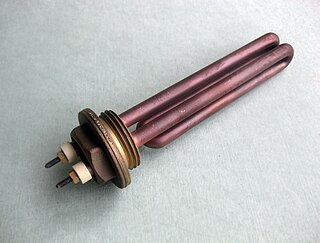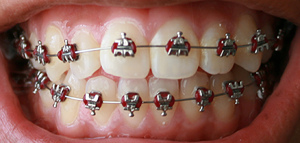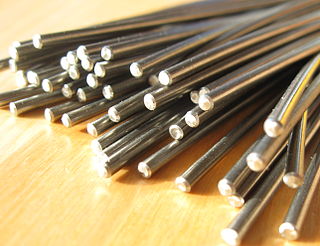Related Research Articles

Rhenium is a chemical element; it has symbol Re and atomic number 75. It is a silvery-gray, heavy, third-row transition metal in group 7 of the periodic table. With an estimated average concentration of 1 part per billion (ppb), rhenium is one of the rarest elements in the Earth's crust. It has the third-highest melting point and second-highest boiling point of any element at 5869 K. It resembles manganese and technetium chemically and is mainly obtained as a by-product of the extraction and refinement of molybdenum and copper ores. It shows in its compounds a wide variety of oxidation states ranging from −1 to +7.

A thermocouple, also known as a "thermoelectrical thermometer", is an electrical device consisting of two dissimilar electrical conductors forming an electrical junction. A thermocouple produces a temperature-dependent voltage as a result of the Seebeck effect, and this voltage can be interpreted to measure temperature. Thermocouples are widely used as temperature sensors.

Young's modulus is a mechanical property of solid materials that measures the tensile or compressive stiffness when the force is applied lengthwise. It is the modulus of elasticity for tension or axial compression. Young's modulus is defined as the ratio of the stress applied to the object and the resulting axial strain in the linear elastic region of the material.
Nichrome is a family of alloys of nickel and chromium commonly used as resistance wire, heating elements in devices like toasters, electrical kettles and space heaters, in some dental restorations (fillings) and in a few other applications.

In electromagnetism, permeability is the measure of magnetization produced in a material in response to an applied magnetic field. Permeability is typically represented by the (italicized) Greek letter μ. It is the ratio of the magnetic induction to the magnetizing field as a function of the field in a material. The term was coined by William Thomson, 1st Baron Kelvin in 1872, and used alongside permittivity by Oliver Heaviside in 1885. The reciprocal of permeability is magnetic reluctivity.

Constantan, also known in various contexts as Eureka, Advance, and Ferry, refers to a copper-nickel alloy commonly used for its stable electrical resistance across a wide range of temperatures. It usually consists of 55% copper and 45% nickel. Its main feature is the low thermal variation of its resistivity, which is constant over a wide range of temperatures. Other alloys with similarly low temperature coefficients are known, such as manganin.
Resistance thermometers, also called resistance temperature detectors (RTDs), are sensors used to measure temperature. Many RTD elements consist of a length of fine wire wrapped around a heat-resistant ceramic or glass core but other constructions are also used. The RTD wire is a pure material, typically platinum (Pt), nickel (Ni), or copper (Cu). The material has an accurate resistance/temperature relationship which is used to provide an indication of temperature. As RTD elements are fragile, they are often housed in protective probes.

A heating element is a device used for conversion of electric energy into heat, consisting of a heating resistor and accessories. Heat is generated by the passage of electric current through a resistor through a process known as Joule Heating. Heating elements are used in household appliances, industrial equipment, and scientific instruments enabling them to perform tasks such as cooking, warming, or maintaining specific temperatures higher than the ambient.
Nisil is an alloy of nickel and silicon with traces of Mg, which is non-magnetic.

An archwire in orthodontics is a wire conforming to the alveolar or dental arch that can be used with dental braces as a source of force in correcting irregularities in the position of the teeth. An archwire can also be used to maintain existing dental positions; in this case it has a retentive purpose.
The specific strength is a material's strength divided by its density. It is also known as the strength-to-weight ratio or strength/weight ratio or strength-to-mass ratio. In fiber or textile applications, tenacity is the usual measure of specific strength. The SI unit for specific strength is Pa⋅m3/kg, or N⋅m/kg, which is dimensionally equivalent to m2/s2, though the latter form is rarely used. Specific strength has the same units as specific energy, and is related to the maximum specific energy of rotation that an object can have without flying apart due to centrifugal force.
Chromel is an alloy made of approximately 90% nickel and 10% chromium by weight that is used to make the positive conductors of ANSI Type E (chromel-constantan) and K (chromel-alumel) thermocouples. It can be used at temperatures up to 1,100 °C (2,010 °F) in oxidizing atmospheres. Chromel is a registered trademark of Concept Alloys, Inc.

Hafnium(IV) oxide is the inorganic compound with the formula HfO
2. Also known as hafnium dioxide or hafnia, this colourless solid is one of the most common and stable compounds of hafnium. It is an electrical insulator with a band gap of 5.3~5.7 eV. Hafnium dioxide is an intermediate in some processes that give hafnium metal.

An aluminium alloy (UK/IUPAC) or aluminum alloy is an alloy in which aluminium (Al) is the predominant metal. The typical alloying elements are copper, magnesium, manganese, silicon, tin, nickel and zinc. There are two principal classifications, namely casting alloys and wrought alloys, both of which are further subdivided into the categories heat-treatable and non-heat-treatable. About 85% of aluminium is used for wrought products, for example rolled plate, foils and extrusions. Cast aluminium alloys yield cost-effective products due to the low melting point, although they generally have lower tensile strengths than wrought alloys. The most important cast aluminium alloy system is Al–Si, where the high levels of silicon (4–13%) contribute to give good casting characteristics. Aluminium alloys are widely used in engineering structures and components where light weight or corrosion resistance is required.

A nanocrystalline (NC) material is a polycrystalline material with a crystallite size of only a few nanometers. These materials fill the gap between amorphous materials without any long range order and conventional coarse-grained materials. Definitions vary, but nanocrystalline material is commonly defined as a crystallite (grain) size below 100 nm. Grain sizes from 100 to 500 nm are typically considered "ultrafine" grains.
6061 aluminium alloy is a precipitation-hardened aluminium alloy, containing magnesium and silicon as its major alloying elements. Originally called "Alloy 61S", it was developed in 1935. It has good mechanical properties, exhibits good weldability, and is very commonly extruded. It is one of the most common alloys of aluminium for general-purpose use.

Nickel titanium, also known as nitinol, is a metal alloy of nickel and titanium, where the two elements are present in roughly equal atomic percentages. Different alloys are named according to the weight percentage of nickel; e.g., nitinol 55 and nitinol 60.

A thermoelectric generator (TEG), also called a Seebeck generator, is a solid state device that converts heat directly into electrical energy through a phenomenon called the Seebeck effect. Thermoelectric generators function like heat engines, but are less bulky and have no moving parts. However, TEGs are typically more expensive and less efficient. When the same principle is used in reverse to create a heat gradient from an electric current, it is called a thermoelectric cooler.
Nicrosil is a nickel alloy containing about 14.4% chromium, 1.4% silicon, and 0.1% magnesium.

Solder is a metallic material that is used to connect metal workpieces. The choice of specific solder alloys depends on their melting point, chemical reactivity, mechanical properties, toxicity, and other properties. Hence a wide range of solder alloys exist, and only major ones are listed below. Since early 2000s the use of lead in solder alloys is discouraged by several governmental guidelines in the European Union, Japan and other countries, such as Restriction of Hazardous Substances Directive and Waste Electrical and Electronic Equipment Directive.
References
- ↑ "Working with Chromel, Alumel & Constantan". Keats Manufacturing Co. 2015-03-12. Retrieved 2017-01-10.
- ↑ Concept Alloys, Inc. Intellectual Property retrieved 12 April 2016
- ↑ Horton, J. L.; Kollie, T. G.; Rubin, L. G. (1977). "Measurement of B versus H of Alumel from 25 to 180 °C". Journal of Applied Physics. 48 (11): 4666. Bibcode:1977JAP....48.4666H. doi: 10.1063/1.323530 .
- ↑ "Physical Properties of Thermoelement Materials" (PDF). Omega.com. Archived from the original (PDF) on 2017-07-24. Retrieved 2018-04-24.
- ↑ "Super Alloy Alumel". AZoM.com. 2012-11-09. Retrieved 2017-01-10.